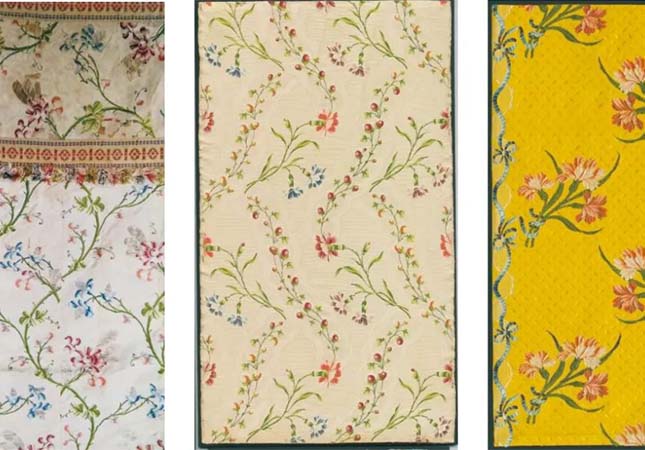The French silk patterns in the 18th and 19th centuries were influenced by Italy and other traditional European silk powers in the early days. The patterns are mainly in the dignified Baroque style, and the "Bizarre", "Lace-patterned silks" and patterns combining stripes and patterns that weaving by early jacquard loom machine have been popular at that time.

In the 1830s, the dot dyeing method invented by Jean Rive gradually gave the pattern a three-dimensional effect. Therefore, the pattern expression of Western silk fabrics represented by France is different from that of the Chinese Ming and Qing Dynasties. The pattern of fruit, flower, and architectural have been widely used and have continued, with the change in the flower during develop process. The flower size has changed from as big as the whole pattern in the early designs to small scattered bouquets or scattered florets in the 1780s.
Thanks for the applications of pattern cards on the jacquard machine at that time, but the early pattern cards were limited by the number of pattern needles, that is, the size of the cardboard limited the number of holes punched, resulting in the pattern not being able to be enlarged. In the 1840s, the Rococo style developed from architecture to silk pattern design. Due to the influence of Chinese art in the formation process, its cumbersome style is similar to the artistic design ideas of the Qing Dynasty in China. The natural and fresh colors, the rolled plants and flowers, and soft curves patterns are becoming more and more popular in the design. The pattern also gradually changed from the "S" shape to the "Z" shape after the 1850s. This kind of change is also due to the number of stitches limitation. The early fabrics were woven on the wire heald jacquard machine. Due to the improvement of the wire heald jacquard machine, the expression of the pattern can be as delicate as possible without considering the problem of the pattern card limitation. After the use of pattern cards, because of the limitation of the number of pattern needles, the change of warp is limited, so it must use oblique lines instead of curves, such as the "Z" shape to express wavy curves within the range of the number of warps as few as possible.
In the 1860s, influenced by the archaeological boom caused by the excavation of historical sites such as the ancient city of Pompeii, neoclassicism became the mainstream style of French silk fabric patterns from the end of the 18th century to the beginning of the 19th century. Classical patterns in this period can be roughly divided into 2 categories: one type is mainly patterned and arranged symmetrically in geometric and prismatic shapes, paying attention to the tranquility and symmetry of classical styles, and advocating the static beauty of balance and rationality; the other type is more Realistic, the patterns are mainly garlands, trophies, musical instruments, wild birds, etc., complicated and gorgeous. At this time, both jacquard fabrics that use wire healds and pattern cards, have been relatively mature. The former generally uses pattern cards as punch cards, so it usually uses symmetrical methods to save pattern needles; the latter generally uses thread-heald pattern punch cards, regardless of the cost, it serves the royal family and nobles more.
The patterns of French silk weaving fabrics in the 18th and 19th centuries were wonderful and changeable. It is not difficult to find that the improvement of the pattern board equipment, the invention, and improvement of the jacquard loom, and the change in the size of the flower book and the number of stitches, made the pattern experience changes from flat to three-dimensional, and from large to small to large. Behind these changes, there is not only the renewal of literary fashion but also the support of the development of silk-weaving technology. It is the continuous innovation and exploration of skills by countless silk-weaving engineers. It is the crystallization of the labor wisdom of countless textile workers. The bright technical points are worthy of study and reference by modern silk people, to contribute to the digitization and intelligence of Chinese silk.




